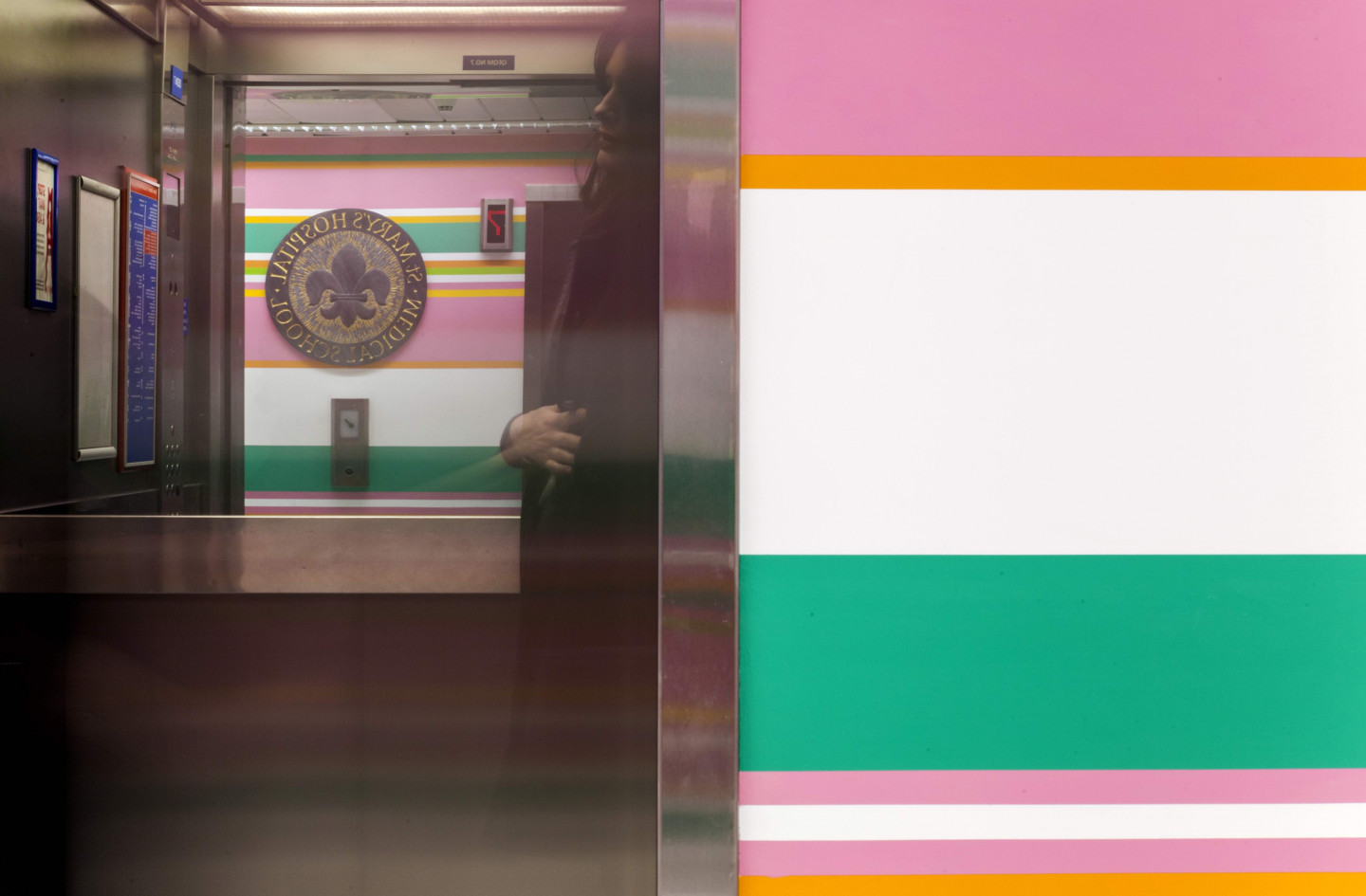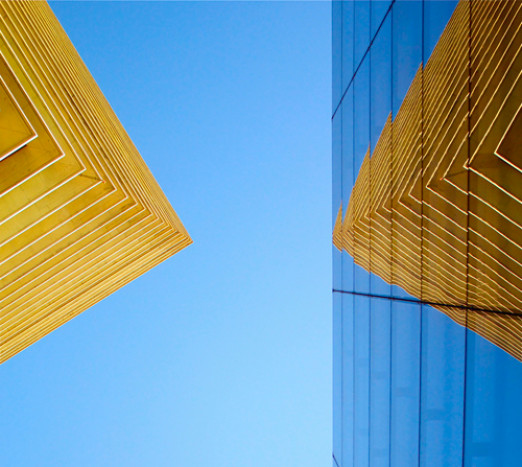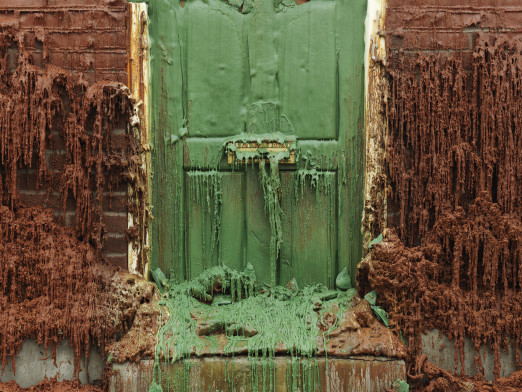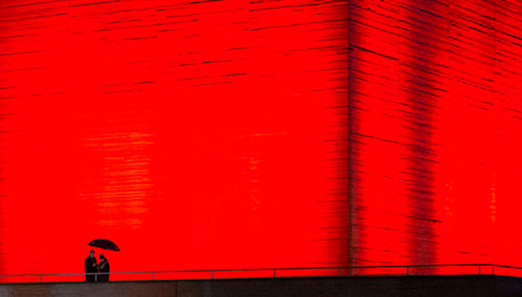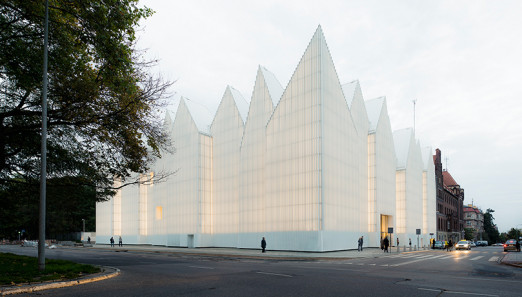Dennis Gilbert, photographer and director of architecture image library View Pictures, on the changing forces driving architectural photography.
On a ‘typical’ architectural shoot what is the brief, the story that needs to be told? Has this ‘typical’ brief changed over the years?
Dennis Gilbert: I don’t believe there has been that much change there, I always see it as a story, just as you put it. I tend to the circumnavigate the building, looking for the right moment to make a range of images from the broadest context to pictures revealing details of materials and texture. Commissioning architects are always going to suggest views, so that is a challenge that remains constant: to make viewers see the architecture in the way that you want them to see it.

(Lenbachhaus Munich, Foster and Partners. Photo ©Dennis Gilbert/VIEW. The new extension is seen through the context as an opening to the narrative.)
In what ways does the photographic image shape the perception of physical buildings and public spaces? Can you give a sense of the photograph’s commercial or cultural power, how it makes a difference?
Dennis Gilbert: We rely on photographs of buildings and the environment to help us make judgements in several crucial areas: whether a building is acceptable or not, in terms of the context, the city, the landscape, the people using it, the design itself — to name a few. Not many people actually see the building or experience its space, volume or presence in the city or on the street. It is difficult to conceive of building practice entirely without photography. So the actual style of the picture, whether glamorous or not, soberly documented or highly manipulated— becomes more and more significant. There was a time towards the end of the analogue film era when it was easily possible to distinguish between a photograph and a architect’s rendering; not so now: a photograph and the intentionally seductive rendering can be difficult to distinguish. Manipulation of the pixels can give the impression that [sometimes] the pure idea of the building has been achieved on the ground.

(Bar no jardim 9 de Abril Lisbon, Aspa Arquitectos. Photo ©Fernando Guerra/VIEW. Guerra is an energetic and innovative photographer who supplies a large number of formally composed graphic images of each building.)
Which photographers, architectural or otherwise, have shifted the dominant conventions of architectural photography?
Dennis Gilbert: Walker Evans, not strictly an ‘architectural’ photographer, comes to mind first. He made some remarkably straightforward yet poetic pictures of the depression-hit southern USA, which suggests to me that. Stephen Shore or Robert Adams follow Evans's interest in investigating "what the present will look like as the past" as he put it. The more client-pleasing British pair Dell & Wainwright (1930s/1940s) introduced a graphic, often dramatically lit, style of picture to the architectural journals in the UK. They made commercial, instantly communicative pictures and helped popularise Modernist architecture in Britain — though we may not know it now.
At about the same time Julius Shulman was shooting new homes in California which promoted his clients’ work, virtually making propaganda for the modern lifestyle on the west coast.
Although he was a great pioneering influence, there doesn’t seem to be great deal of warmth behind his pictures. In different ways, key photographers have helped us re-think architecture through the image: Henk Snoek (mass, space, muscle); Ezra Stoller (classically formal compositions); the Bechers (ordered collections of structures). In the UK John Donat and Tony Ray Jones (1960/1970s) took a more documentary approach (with roll film cameras), including people and adding some spontaneity to the genre. It is not anything new to do this as many writers suggest.
Ken Kirkwood, Richard Bryant, Martin Charles and Peter Cook dominated the 1980s and 1990s in the UK with, once again, more formal man-camera-building pictures that were unambiguously making you stand face to face with the architecture again.

(Bridget Riley’s work at St Mary’s Hospital, London. Photo ©Peter Cook/VIEW. Peter Cook’s work always seems true to his view of the architecture and the light, rather than some kind of presentation of the designer’s work.)

(Arnhem Central Station, UN Studio. Photo ©Christian Richters/VIEW. Richters has been a mainstay of fine, straight photography for decades, predominantly on the European mainland.)
Once digital photography arrives, we can't ignore Iwan Baan, a phenomenal traveller, shooting into the light, and almost routinely from the air regardless of location, who introduces a wide and wild documentary style back into the medium. Now all is possible with the full histogram at your service, though it seems the mid-tone button is moving towards the highlights: some work is ever lighter than before. That is at this particular moment.

(Szczecin Philharmonic Hall, Szczecin, Studio Barozzi Veiga. Photo ©Hufton and Crow/VIEW: Great formal and digital control evident here.)
To what extent do architects and architectural practices become associated with the style of individual photographers?
Dennis Gilbert: Every photographer’s dream — to be the continuing interpreter of a practice’s work. This can be all too rare, which is surprising in my mind, since photographers can do very different things to the same building. Architects are interested in a picture that fits their concept of the building of course, but it is rare for them to see great differences in the photography. There is no doubt that part of Norman Foster’s success is owing to his impeccable presentations of his built work: he never undervalued the power of the photograph to assist in winning the next job. Most photographers will tell you that these ‘sticky’ clients can be counted on one hand.

(Timberyard Housing Dublin. O’Donnell + Tuomey. Photo ©Dennis Gilbert/VIEW. An example of a practice that generally uses one practitioner to photograph their work.)
You have mentioned how digital means that a large volume of images can be shot, with the edit/story emerging rather than planned or ‘storyboarded’. Does this mean arriving at the same result through different methods? Or has it made a material difference to the visual storytelling of the building or space?
Dennis Gilbert: In the end, the architect will consistently use perhaps 5 images in a presentation: the difference is that he may have to edit from say 50-200 from the photographer plus some very decent shots taken by his project architect during the build, and folders of others from the team. Probably thousands. So it is an editing headache, but no doubt also an opportunity to use a couple of unusual shots taken by others. So, yes, I am sure the story looks different now, possibly less formally consistent than in the time when the pictures would be largely from one source.

(Serpentine Pavilion 2011, Peter Zumthor. Photo ©Hufton and Crow/VIEW. Zumthor, often a critic of pictorial interpretation instead of an actual visit has been quoted, "I cannot stand architecture becoming part of a marketing strategy.” He tends to commission Helene Binet for his work. "The best thing is if somebody else does their own work of art or a personal work of literature or criticism. You can feel this other person reacting to what he or she sees and then it doesn’t try to represent, but is a thing in itself.”)
You have noted a shift from formalism toward documentary style. What do you think is driving this? Who are the leaders in this area? What are the signifiers of the architectural ‘documentary’ image in terms of content and visual styling?
Dennis Gilbert: Architectural photography was formerly associated with a monorail, technical camera with perspective correction: it seemed completely wrong to take a picture on an SLR and then ‘fix’ it digitally. In any case, it also seemed that a different photograph was taken: that is, you could not get the same result by digital means. That has now changed but the rigorous approach is fading. We can now hand-hold, use drones, easily include people, react quickly and there is no cost for the extra ‘shot from over here’… except in terms of the time for the photography, post production and subsequent editing required. The making of the photograph is so relatively simple, there need be no formal apprenticeship or training — or so one may be led to believe. A large camera, with a significant expense for every shot, made the decision to place the camera in a certain place and in a certain direction, much more of a crafted process. On the other hand, if you look at current magazines, photographers are still working in a very formal way most of the time: serious architecture demands an approach that frames it with due care. The signifiers: drone views, less formal composition, a more spontaneous feel, wider lenses, not perfect weather.

(Medical School Limerick, Grafton Architects. Photo ©Dennis Gilbert/VIEW. Not traditionally ‘perfect’ weather but the quick reaction digital photography allows, made this image possible between showers, and it is a true rendering of the location’s weather.)

(The Lattice house, Jammu Khashmir, India. Architect: SP+A. Photo ©Edmund Sumner/VIEW. The building and context in a magnificent collage.)

(The Cockcroft Building Brighton. Fraser Brown MacKenna. Photo ©Richard Chivers/VIEW. The hallmarks of traditional architectural photography in digital form.)

(Beach Road Development Singapore. Foster and Partners. Photo ©Dennis Gilbert/VIEW. This picture would probably not have been attempted in analogue days: the actual contrast and range of exposure might have made it less successful.)
To what extent are photographers making use of new drone technology? Can such technology give us a different perspective on buildings?
Dennis Gilbert: Drone, or helicopter, pictures are probably the most significant innovation introduced by Iwan Baan in particular. Literally a different perspective: of course aerial photography has long existed but here it is being used specifically to set a building in wider context, almost as if describing it to an alien visitor. Many others are using drones but more interesting is the number of photographers making short films, videos or clips. Although currently the younger generation is much more relaxed about pigeon-holing careers, I doubt that all these photographers have film language as part of their skills: many are teaming up with film-makers or editors, which seems to be a logical path.
For more info on Viewpictures

(Jockey Club Hong Kong. Zaha Hadid Architects. Photo ©doublespace/VIEW. The aerial view does not have to be from a drone. It adds a viewpoint that few visitors to the building can experience.)
